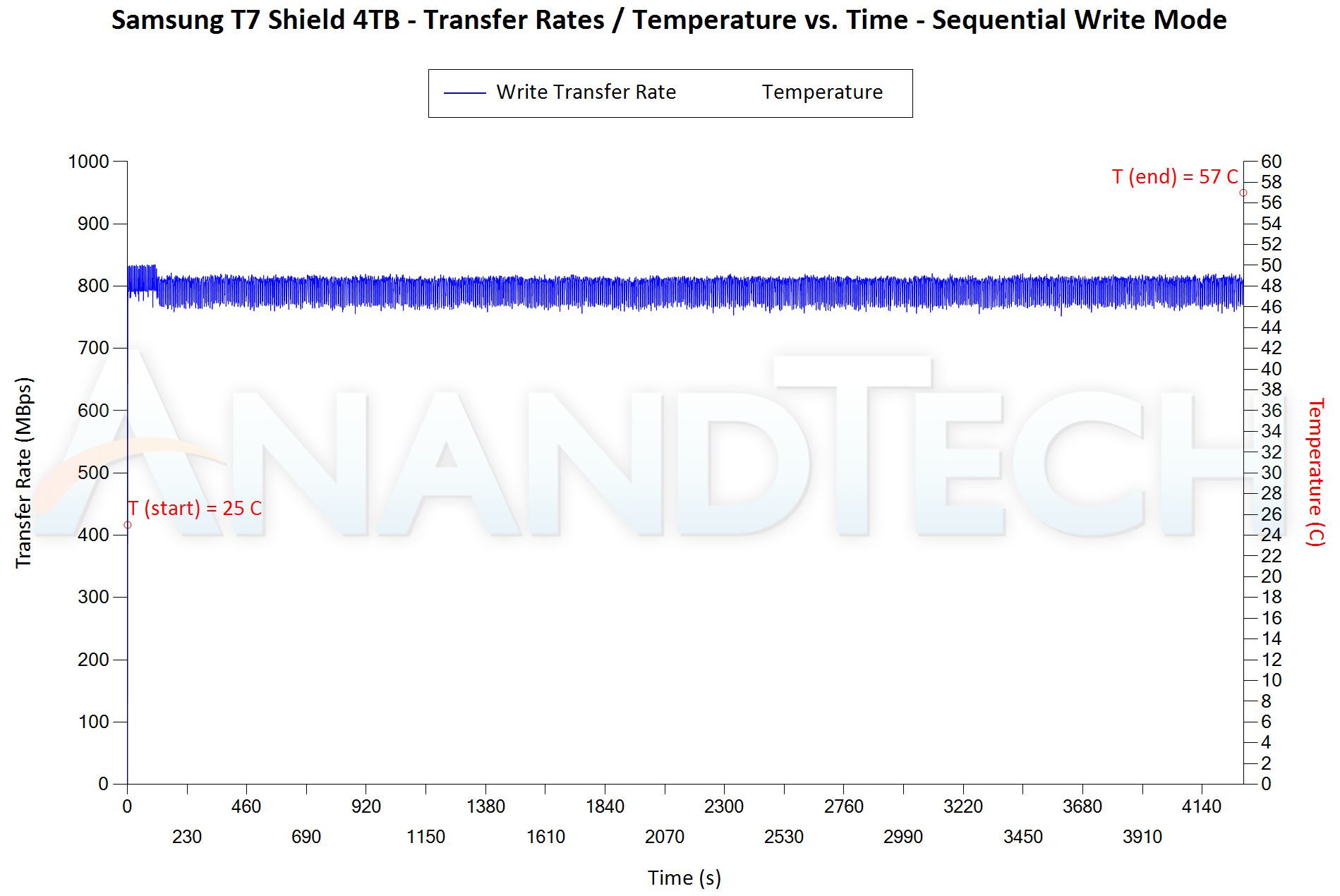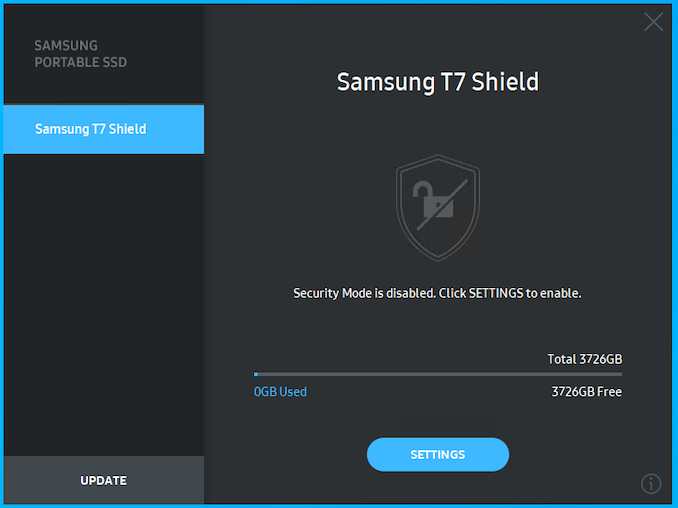Samsung Portable SSD T7 Shield 4TB Review: IP65 PSSD Gets a Capacity Upgrade
by Ganesh T S on January 31, 2023 10:00 AM ESTMiscellaneous Aspects and Final Words
The performance of the storage bridges / drives in various real-world access traces as well as synthetic workloads was brought out in the preceding sections. We also looked at the performance consistency for these cases. Power users may also be interested in performance consistency under worst-case conditions, as well as drive power consumption. The latter is also important when used with battery powered devices such as notebooks and smartphones. Pricing is also an important aspect. We analyze each of these in detail below.
Worst-Case Performance Consistency
Flash-based storage devices tend to slow down in unpredictable ways when subject to a large number of small-sized random writes. Many benchmarks use that scheme to pre-condition devices prior to the actual testing in order to get a worst-case representative number. Fortunately, such workloads are uncommon for direct-attached storage devices, where workloads are largely sequential in nature. Use of SLC caching as well as firmware caps to prevent overheating may cause drop in write speeds when a flash-based DAS device is subject to sustained sequential writes.
Our Sequential Writes Performance Consistency Test configures the device as a raw physical disk (after deleting configured volumes). A fio workload is set up to write sequential data to the raw drive with a block size of 128K and iodepth of 32 to cover 90% of the drive capacity. The internal temperature is recorded at either end of the workload, while the instantaneous write data rate and cumulative total write data amount are recorded at 1-second intervals.
| Sequential Writes to 90% Capacity - Performance Consistency | |
| TOP: | BOTTOM: |
 |
|
 |
|
Similar to its 2TB cousin, the 4TB T7 Shield doesn't have a SLC cache cliff. Other PSSDs have notable performance loss after the initial write burst. The SanDisk Extreme PRO's loss is from a higher level and its steady state is still much better than the theoretical limit of 1GBps-class PSSDs. Thermal performance is excellent and similar to that of the 2TB version of the T7 Shield.
Power Consumption
Bus-powered devices can configure themselves to operate within the power delivery constraints of the host port. While Thunderbolt ports are guaranteed to supply up to 15W for client devices, USB 2.0 ports are guaranteed to deliver only 4.5W (900mA @ 5V). In this context, it is interesting to have a fine-grained look at the power consumption profile of the various external drives. Using the Plugable USBC-TKEY, the bus power consumption of the drives was tracked while processing the CrystalDiskMark workloads (separated by 5s intervals). The graphs below plot the instantaneous bus power consumption against time, while singling out the maximum and minimum power consumption numbers.
| CrystalDiskMark Workloads - Power Consumption | |
| TOP: | BOTTOM: |
 |
|
 |
|
Despite the additional flash packages, the power consumption profile of the 4TB version is very similar to that of the 2TB version. Peak power consumption is around 4W, and there is a deep-sleep mode after 15 or so minutes of inactivity where the PSSD draws just 160 mW from the host.
Concluding Remarks
The Samsung Portable SSD T7 Shield 4TB version is available for purchase today. The official launch MSRP is $430, but we already saw the PSSD for sale at $410. This pricing is completely untenable, given the price of competing PSSDs. The SanDisk Extreme PRO v2 comes with a USB 3.2 Gen 2x2 20 Gbps interface, has a much better performance profile across all considered workloads, and the 4TB version is currently available for $360. On the flip side, it is only IP55-rated, and the power consumption numbers are a bit on the higher side.
If the PSSD is priced between $250 and $300 (closer to the Crucial X6), one can look past the disappointing random access performance and the DRAM-less nature that affects performance for workloads of power users (including application launches and read/write of small files). Even at the higher end of that pricing spectrum, one can say that the PSSD would deliver excellent value for typical direct-attached storage workloads. The IP65 rating and low power consumption, coupled with the hardware encryption capabilities (controllable via the Samsung Portable SSD Software) are important value additions. Samsung's upcoming release of their Magician software is also expected to introduce cloning of internal SSDs to PSSDs such as the T7 Shield.
In terms of scope for improvement, we believe Samsung should offer DRAM-equipped PSSDs in a slightly premium line - those could deliver better performance for non-DAS workloads (and PSSDs are starting to get treated on par with internal SSDs by power users already). They could also explore supplying a single Type-C to Type-C cable along with an attached Type-C to Type-A adapter.
In conclusion, while the performance and feature set of the Portable SSD T7 Shield are acceptable for an entry-level PSSD, the pricing appears to be one meant for a high-end one. The market deserves a wider range of PSSD offerings from Samsung with varied performance levels and commensurate pricing.












12 Comments
View All Comments
ballsystemlord - Tuesday, January 31, 2023 - link
This drive loses to it's own other SKUs. I'm laughing at it. This is ridiculous, especially at this price point.ganeshts - Tuesday, January 31, 2023 - link
It is not surprising to see high-capacity SKUs fare a bit worse than the lower capacity ones, but, yes, the gulf in random performance is quite bad.It appears Samsung has optimized completely for sequential DAS workloads (we can see improvement in the 'SLC cliff' scenario), but at the cost of random access performance.
kkromm - Tuesday, January 31, 2023 - link
You can buy any number of NVME thunderbolt enclosures add your own SSD and far exceed these numbers for the same price. The fastest speed I have gotten so far is the new Samsung 990 Pro which was close to 2700mps read and write, but that is only available in 2TB.ganeshts - Tuesday, January 31, 2023 - link
IP65-rated enclosures for NVMe SSDs are not very common. Also, 4TB internal SSDs are way overpriced compared to their external counterparts.There is a value proposition possible with these high-capacity PSSDs (very evident in the Crucial X6 and SanDisk Extreme Pro v2) - just that the current pricing makes it a bad one for the T7 Shield.
Chaitanya - Tuesday, January 31, 2023 - link
4TB version of that drive is supposed to be released in March or April. Its a real shame Samsung has been sticking 2TB as upper celing on their M.2 drives for for so long while there are higher capacity M.2 drives on market for quite sometime now and seem to be selling well.Shame that Samsung has started to fully solder components on their external SSDs while in past there was an option to remove SSD in case of failure.
Alistair - Friday, February 3, 2023 - link
I bought the Asus external nvme SSD enclosure, the most expensive one. Nothing but problems, random disconnects. Meanwhile my Samsung external is reliable. So yeah.Samus - Wednesday, February 1, 2023 - link
It's shit products like this that are still having enthusiasts building their own portable SSD's out of an NVMe USB adapter, which cost less, cool better and achieve 20Gbps.meacupla - Wednesday, February 1, 2023 - link
I'm genuinely curious to know if IP65 is even necessary.Do people spill liquids onto their external drives?
I know that people spill liquids onto their laptops and keyboards all the time, because those are in the primary work space, and people tend to put their drinks in that space.
However, I have yet to encounter anyone who got liquid onto their external drive, because those tend to sit off to the side, or behind the primary work space.
CalifLove00 - Monday, February 13, 2023 - link
I wonder this very thing. Maybe for the crowd that treats these things like USB thumb sticks.. I have washed a few of those by mistake in laundry...I suppose it's possible? I'd like to think people are a little more careful with $100+ devices than free ones but you never know? Beyond that - the water/dust resistance of this drive isn't a needle mover for me.Maldon - Friday, February 17, 2023 - link
Some people use their portable drives outdoors, away from the protection of a building. That's one of the advantages of portable storage. When I'm trekking in the Himalaya or Andes, it's reassuring to know my portable SSDs are IP65 rated. You never know when your bag is going to fall into a mountain stream or get drenched in a rain storm. Of course you can wrap everything in plastic bags or use a waterproof PeliCase, but extra protection for irreplaceable photos and video files is important.